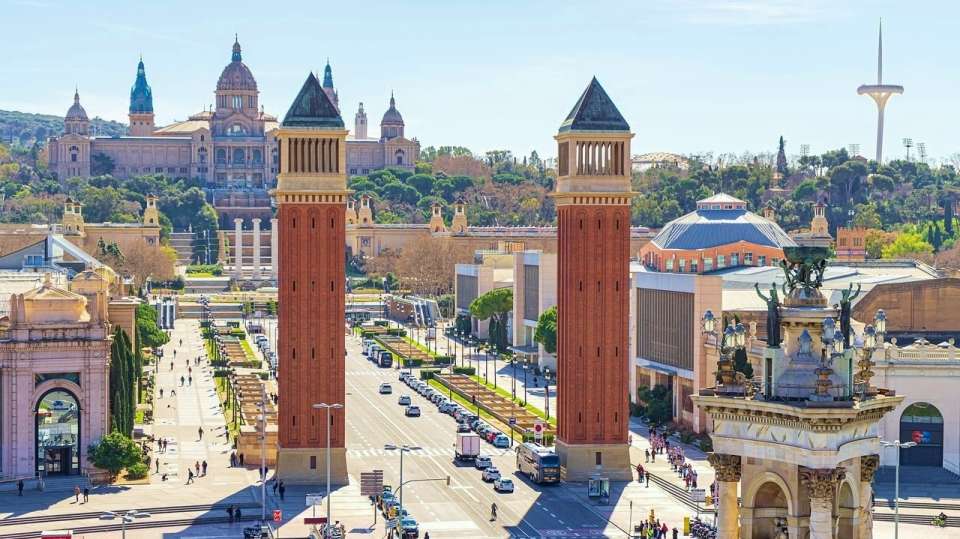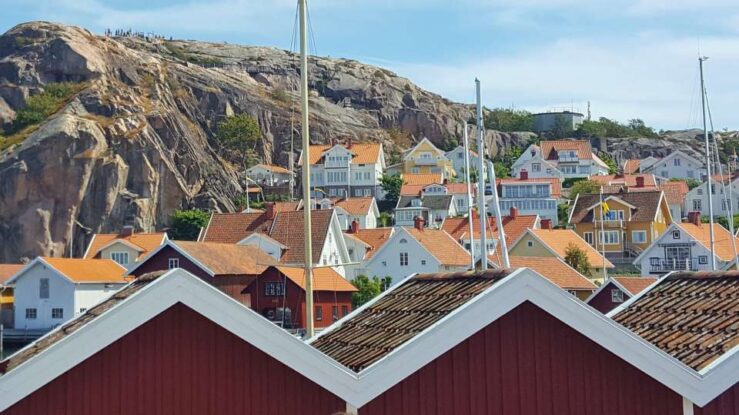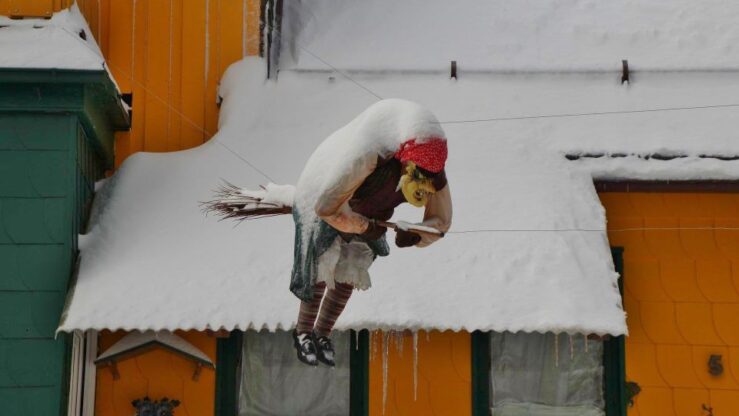Where to Stay in Barcelona
The 6 Best Areas & Places
1. Barri Gòtic / Las Ramblas
2. La Ribera / El Born
3. Barceloneta
4. Eixample
5. Montjuïc / El Poble Sec
6. La Vila Olímpica del Poblenou
Where to stay in Barcelona (before a cruise) – What are the best areas/places? The old city, Ciutat Vella, consists of four smaller neighbourhoods: Barri Gòtic, El Raval (the former Barri Xinès), Barceloneta and La Ribera / El Born. The main artery is the famous pedestrian street, Las Ramblas, connecting Plaça de Catalunya with the Christopher Columbus column.
North of Ciutat Vella, you have the architecturally fascinating Eixample district with its eye-catching urban grid layout and renowned Modernist architecture – and even further north, the bohemian Gràcia featuring charming little cafés, local ambience and a vibrant nightlife in the Plaça del Sol. Gaudí’s eye-catching Parc Güell is also in this neighbourhood.
Gaudí in Barcelona
3-day itinerary for Madrid
Santiago de Compostela
What is the best area to stay in Barcelona?
Barcelona is surrounded by mountains, and to the east of central Barcelona, right above El Poble Sec, the former lower-class area – today a popular district, Montjuïc, rises with all its attractions. On the other side, the city is bounded by the mountain Tibidabo, featuring an amusement park on the hilltop. Finally, to the east, you will reach El Poblenou and the modern Vila Olímpica, constructed for the 1992 Olympic Games.
So how can you decide which neighbourhood / where to stay in Barcelona when visiting the Catalan capital – what are the best places, hotels and areas to pick for your visit – whether you are a first-time visitor, a family, on a budget, or need to stay before a cruise? Below, you will find some of our favourite neighbourhoods, areas and places to stay in Barcelona – described for each district.
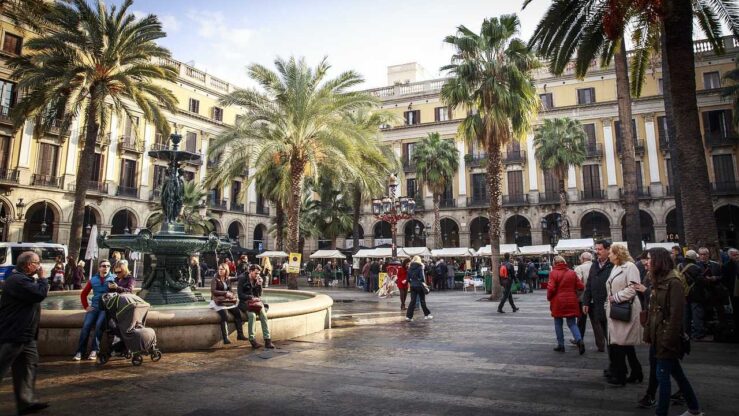
Best Neighbourhoods to Stay in Barcelona | Photo: Kristina Spisakova / Pixabay
If you want to stay amid the narrow and intricate medieval streets in Barcelona in one of the places strongly dominated by Gothic-style architecture, one of your best options will be the areas to the right of Las Ramblas – where you will find authentic Gothic constructions a bit everywhere. The ambience is fabulous here – and so is the acoustics in the squares when you listen to the local musicians playing! Take a stroll on Las Ramblas for people-watching and ‘feel’ the vibe and the Catalan way of life!
Las Ramblas is the generally crowded plane tree-lined boulevard separating the two neighbourhoods El Raval on the left-hand side and the Barri Gòtic, the Gothic Quarter, on the right-hand side. A stroll along Las Ramblas is often entertaining since it is Barcelona’s vibrant and lively pedestrian street, where flower sellers and human statues pose for a photo and a few coins.
The Barri Gòtic neighbourhood is also one of the best places in Barcelona where you can stay conveniently in the shadow on a warm summer day in one of the small hidden plazas – appearing out of nowhere – when you least expect it. Other spectacular and larger squares include the picturesque and popular Plaça Reial and the Plaça de Sant Jaume, flanked by local governmental buildings: the Ajuntament de Barcelona, the City Council, and the Palau de la Generalitat de Catalunya, seat of the Presidency of the Generalitat de Catalunya.
Moreover, it is a great neighbourhood to spend half a day just strolling around, visiting a museum, exploring the small shops, enjoying a Catalan meal in one of the numerous restaurants and finally discovering the local nightlife and bars!
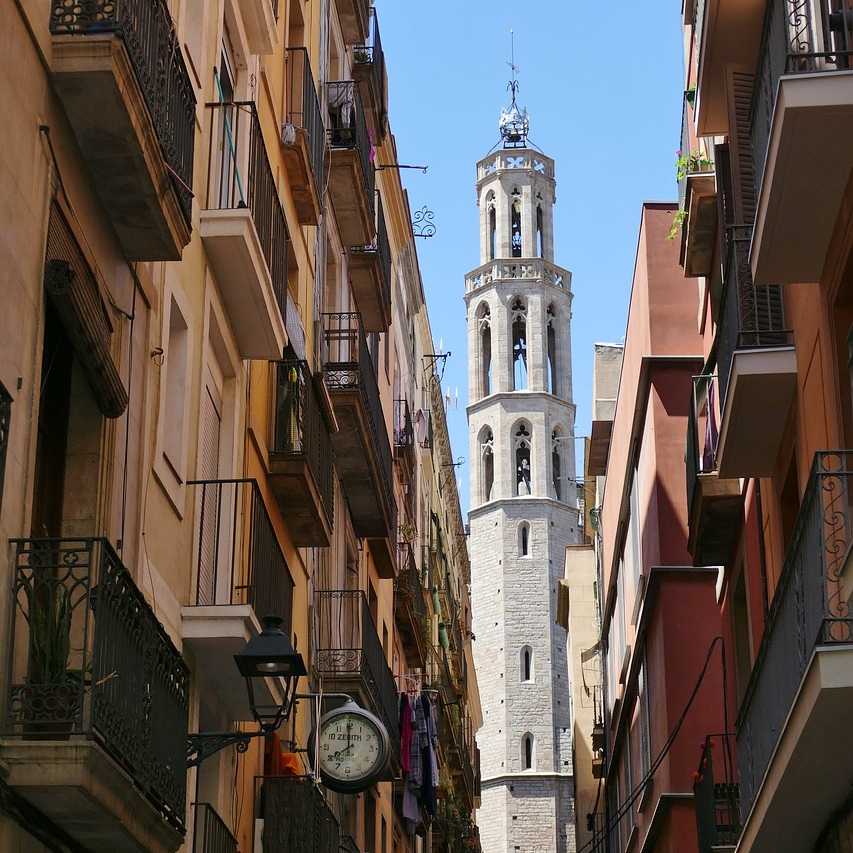
Best Neighbourhoods to Stay in Barcelona | Photo: Falco / Pixabay
It may be one of the best places if you want to stay in the historic neighbourhoods / areas in Barcelona where you can still feel the soul and the spirit of medieval times! The Ribera neighbourhood offers great Gothic architecture in combination with museums, culture, and top-notch bar and restaurant options.
La Ribera / El Born can be found east of the Gothic Quarter. Here, you will arrive at another imposing cathedral, the Catalan Gothic basilica Santa Maria del Mar or ’Saint Mary of the Sea’, built in the 1300s under the Kingdom of Aragon. In newer times, it has become known worldwide thanks to ‘Cathedral of the Sea’, a novel by Ildefonso Falcones.
Another attraction in La Ribera is the Museo Picasso in Montcada Street. It is a world-class museum housed in five adjoining medieval palaces – exhibiting more than 4,200 Picasso works – mainly from around 1900! The museum also features the complete series (58 paintings) of the famous Las Meninas.
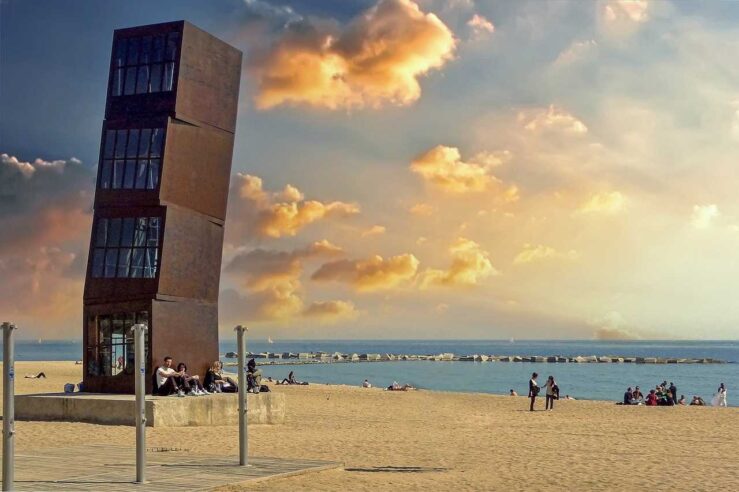
Where to Stay in Barcelona – The 6 Best Areas, Neighbourhoods & Places | Photo: Amduma / Pixabay
Would you like to be near the beach in a former fisherman’s neighbourhood? Then you may want to stay in Barceloneta, the old fishing and seaside village in Barcelona where you can still, today, feel a bit of the old maritime atmosphere. At the same time, the seaside area has – as part of the 1992 Olympic Games preparations – been converted into a splendid and lively city beach. So if your dream is to combine a city break in Barcelona with a beach holiday – maybe if you travel as a family, your best option may be to stay in one of the hotel places around Barceloneta.
The triangular district of rectilinear streets squeezed in between the Rambla de Mar (Barcelona’s Port Vell) and the Port Olímpic saw the day of light when Barcelona had to redesign the old neighbourhoods for the Olympic Games of 1992. The traditional fisherman’s district was converted into a modern beach area with bars and seafood restaurants to meet the demand at the Olympics. Unfortunately, the fishermen’s houses and public baths disappeared with this new beach district approach.
La Barceloneta is the perfect place to try fresh fish, paella or the seafood dish fideuà in Barcelona!
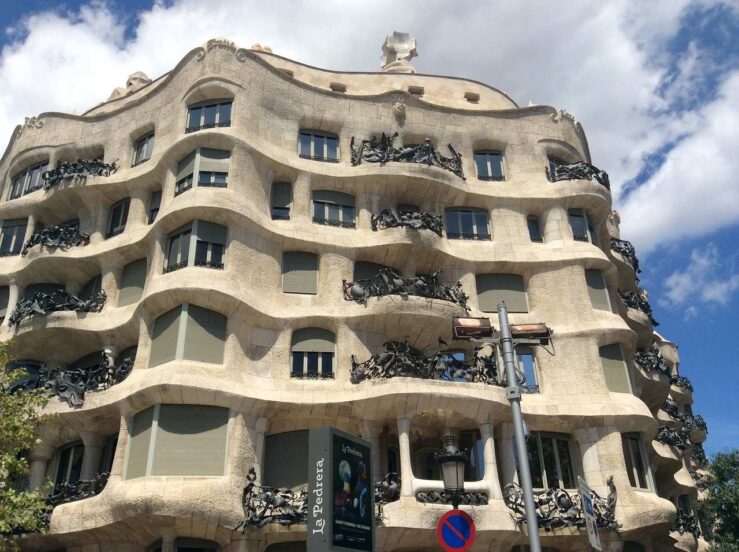
Where to Stay in Barcelona – The 6 Best Areas, Neighbourhoods & Places | Photo: Elena Cagianelli / Pixabay
You will stay in the Eixample areas in Barcelona to experience great architectural works by the famous Modernist architect Antoni Gaudí – for instance near Passeig de Gràcia where you will close to his renowned places Casa Milà and Casa Battló, constructed as residential buildings in the unique Catalan Modernist style. Also, Gaudí’s world-famous unfinished church La Sagrada Familia is in this neighbourhood, so staying in Eixample will make it easy to discover the works of the most eminent Catalan Modernist architect.
In Eixample, you will get a firsthand impression of the spectacular grid pattern proposed and designed by Cerdà – which was Barcelona’s grand expansion project at the end of the 19th century.
The Eixample district was designed by Ildefons Cerdà as a contribution to a development plan for Barcelona towards the end of the 1800s to solve a range of sanitary problems in the city. The Catalan name Eixample means expansion, and the project was an expansion of the city, with a grid of avenues where house blocks were built in octagonal ‘manzanas’, leaving room for spacious squares in between. You will probably know the layout of the streets and building structures from aerial photos of this part of Barcelona, with the diagonal street ‘Diagonal’ cutting right through.
In the right part of Eixample, you will find the Sagrada Familia, Gaudí’s world-famous masterpiece of a basilica, built on a religious background and with religious motives – again including elements from nature and complex geometric natural curves. At his death, it was far from complete – and still is not, but construction works continue, and the basilica will end up with 18 towers – one for each of the 12 apostles, one for each of the evangelists and the last two for Virgin Mary and Jesus.

Where to Stay in Barcelona – The 6 Best Areas, Neighbourhoods & Places | Photo: Kevin Ramirez / Pixabay
Among the popular neighbourhoods – if you would like to enjoy some of the best outdoor places and parks in Barcelona – a bit away from the bustling city, you may stay at the Montjuïc mountain. Here you will find several facilities used for the 1992 Olympic Games, the museum-like Poble Espanyol village with building styles from all over Spain, the Botanical Garden and several other fabulous museums, among others counting the Fundació Joan Miró.
For the most vibrant surroundings, you may stay at the foot of the mountain around El Poble Sec, a multicultural, non-touristy and authentic neighbourhood with local and inexpensive tapas bars and eateries.
‘Poble Sec’ means ‘dry village’ and was the name given to the neighbourhood since it had no water source at all until the late 1800s. El Poble Sec was one of Barcelona’s lower-class areas beyond the city walls. However, this changed with the construction of Eixample and the new urban planning. Successful artists discovered the neighbourhood, and quite a few theatres were established along the avenue Parallel for entertainment, cabarets, and other innovative shows. Also, today, there are plentiful bars, clubs and a diverse cultural scene with theatres such as El Molino, La Ciutat del Teatre and Mercat de les Flors in the area.
From El Poble Sec, you can hike up the Montjuïc mountain, or take the funicular (or cable car). To reach the hilltop, you can also start at the Plaça d’Espanya, the beautiful square with the remarkable fountain built for the International Exhibition in 1929, providing a music and colour show, Font Màgica, and continue from there on foot up the hill.
On Montjuïc, you have the chance to visit the former Olympic Stadium from the 1992 Summer Olympics, the scenic Botanical Garden, Montjuïc Castle, likewise providing stunning views, the world-famous Fundació Joan Miró with outstanding works by the renowned artist, as well as the Poble Espanyol, the village with architectural styles from different regions in Spain.
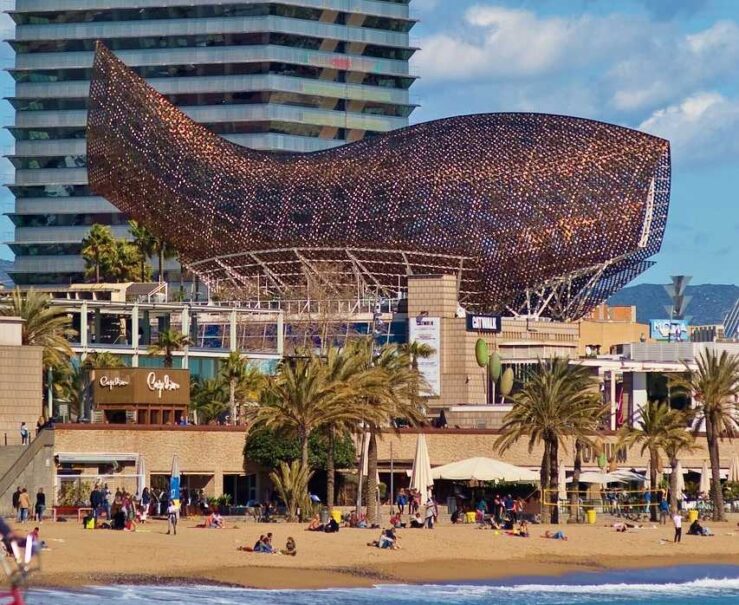
Where to Stay in Barcelona – The 6 Best Areas, Neighbourhoods & Places | Photo: Sosinda / Pixabay
Do you want to stay near the best leisure opportunities and recreational places in Barcelona where you can participate in beach activities and water sports and chill out in the surrounding seaside areas? Would you like plentiful options to enjoy a meal and a drink in a restaurant overlooking the sea? In this case, La Vila Olímpica del Poblenou may be one of the best areas to stay in Barcelona. At the Olympic Marina, you will have over 40 bars and restaurants to choose from!
La Vila Olímpica del Poblenou, known as merely La Villa Olímpica, was constructed at the beginning of the 1990s to house the athletes for the 1992 Summer Olympic Games.
The neighbourhood El Poblenou used to be an industrial and working-class district with numerous factories and residential buildings for the workers. After the gentrification, the district has become popular among young people and artists alike. The modern structures and surroundings include shopping centres, restaurants, bars, discos, and lovely green spaces beyond the attractive beachfront.
The Port Olímpic is the port side of the neighbourhood. Here you can do all kinds of water sports and sailing activities. Featuring a wealth of restaurants, tapas bars, and top-notch discos, it is today a popular place in Barcelona to go out near the beach!
An iconic landmark at the Port Olímpic is El Peix by Frank Gehry from 1992 – a giant goldfish sculptural work at Passeig Marítim de la Barceloneta raised above La Vila Olímpica.
Do you need an itinerary for Barcelona? Check here what you can cover in 5 days: Barcelona – Itinerary 5 Days
Read next: Explore Aigues-Mortes, Camargue and The Dalí Museum in Figueres
Find useful travel gear: Travel Essentials
See: How to Travel Light
Where to Stay in Barcelona – The 6 Best Areas, Neighbourhoods & Places
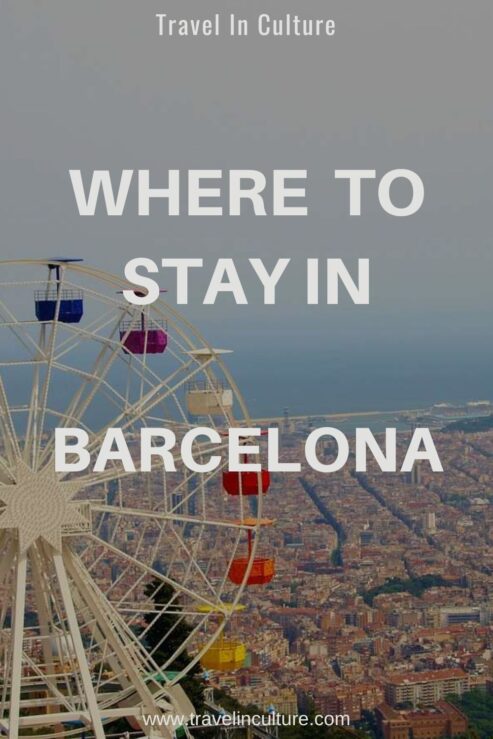
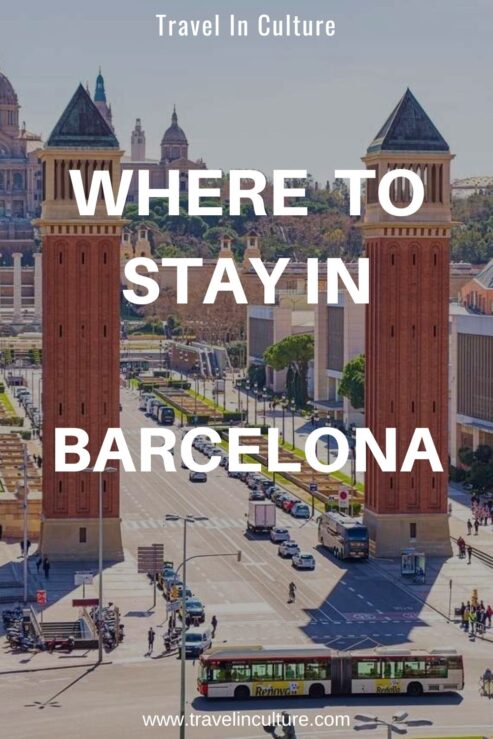
Where to Stay in Barcelona
Barcelona Best Places to Stay – Areas & Neighbourhoods
Featured image of
Where to Stay in Barcelona – The 6 Best Areas, Neighbourhoods & Places:
Dominick Vietor / Pixabay
Best area in Barcelona to stay – Best location to stay in Barcelona – Where to stay in Barcelona before a cruise


